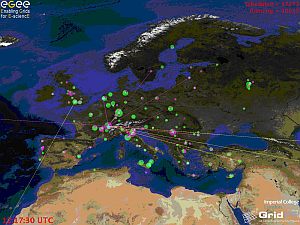The grid computing project “Enabling Grids for E-science (EGEE)” initiated by many international partners together with the Steinbuch Centre for Computing (SCC) provides scientists in research and industry with access to large computing resources irrespective of their location. With EU funds, the EGEE project that has now been completed has established and operated the largest multidisciplinary grid infrastructure worldwide. This infrastructure will be further maintained by the European grid initiative EGI.
The Steinbuch Centre for Computing (SCC) coordinated the consortium of all German project partners and was the spokesman of all nine German and Swiss partners in the EGEE Project Management Board.
In late June this year, the project successfully passed the final review by the European Commission. John Martin, chairman of the EC review panel, declared that EGEE had been an outstandingly successful flagship project with a high visibility and importance in Europe and beyond.
After the project duration of six years, the grid infrastructure established by EGEE supports more than 10,000 scientists worldwide in research. 15 scientific disciplines were covered by the EGEE project, from fusion research to materials science to high-energy physics.
Grids help users to obtain barrier-free access to European or globally distributed computing and storage facilities. The EGEE grid is unique worldwide. It is the largest grid infrastructure in the world. Every month, 15 million programs are executed on 240,000 CPU cores distributed on 315 connected computing centers in 52 countries.
The Grid Computing Centre Karlsruhe (GridKa), German tier-1 center at SCC, is one of the 11 hearts of the EGEE grid. With more than 10,000 CPU cores, more than 8 petabytes of hard disk storage capacity – this corresponds to a volume of nearly 2 million DVDs –, and more than 10 petabytes of associated tape storage capacity, GridKa also is one of the largest installations of its type. In 2009, it executed programs in the amount of 42.8 million CPU hours, corresponding to a computing time of 4880 years.
With the help of GridKa and the other worldwide tier centers of the EGEE grid, scientists were enabled to execute larger projects than before within a shorter period of time. The infrastructure established has thus become the main artery of many fields of research.
Professor Achim Streit, newly appointed director of the SCC, explains: “One of the biggest challenges of grid computing lies in the establishment of sustainable collaborative structures. EGEE has set milestones, from which German and international science will profit in the long term.”
“We congratulate EGEE on its extraordinary success,” says Professor Wilfried Juling, Managing Director of the SCC, “we are very happy that GridKa and the connected tier-2 and tier-3 centers contributed to making this vision come true and we consider it our mission to actively participate in its further development.”
Sustainable extension of the EGEE grid and maintenance of the collaborations established will now be continued under the newly founded European Grid Initiative (EGI.eu) headed by Dr. Steven Newhouse. EGI will be based on the national grid initiatives.
Gauß-Allianz e.V. is in charge of the German NGI-DE (National Grid Initiative Germany). The joint research unit of NGI-DE is managed by KIT, and here by the SCC.
SCC supports the sustainability mission also by other local initiatives. The experience gained from the use of large storage infrastructures in GridKa is now used for establishing a worldwide unique facility, the Large-scale Data Facility (LSDF). It addresses in particular to scientists needing efficient access to large data pools, e.g. morphologists and biologists. Together with the big IT players Hewlett Packard, Intel, and Yahoo, SCC also is founding member of the OpenCirrus Cloud Testbed. Here, techniques of distributed computing in collaborative environments are studied.
Being “The Research University in the Helmholtz Association”, KIT creates and imparts knowledge for the society and the environment. It is the objective to make significant contributions to the global challenges in the fields of energy, mobility, and information. For this, about 10,000 employees cooperate in a broad range of disciplines in natural sciences, engineering sciences, economics, and the humanities and social sciences. KIT prepares its 22,800 students for responsible tasks in society, industry, and science by offering research-based study programs. Innovation efforts at KIT build a bridge between important scientific findings and their application for the benefit of society, economic prosperity, and the preservation of our natural basis of life. KIT is one of the German universities of excellence.

